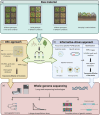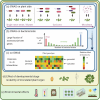Toward Ecologically Relevant Genetics of Interactions Between Host Plants and Plant Growth-Promoting Bacteria
- PMID: 39552649
- PMCID: PMC11561803
- DOI: 10.1002/ggn2.202300210
Toward Ecologically Relevant Genetics of Interactions Between Host Plants and Plant Growth-Promoting Bacteria
Abstract
The social movement to reduce reliance on pesticides and synthesized fertilizers and the growing global demand for sustainable food supplies require the development of eco-friendly and sustainable agricultural practices. In line, plant growth-promoting bacteria (PGPB) can participate in creating innovative agroecological systems. While the effectiveness of PGPB is highly influenced by abiotic conditions and microbe-microbe interactions, beneficial plant-PGPB interactions can also highly depend on both host and PGPB genotype. Here, the state of the art on the extent of natural genetic variation of plant-PGPB interactions and the underlying genetic architecture, in particular in Arabidopsis thaliana is reviewed. Extensive natural plant genetic variation in response to PGPB is associated with a polygenic architecture and genetic pathways rarely mentioned as being involved in the response to PGPB. To date, natural genetic variation within PGPB is little explored, which may in turn allow the identification of new genetic pathways underlying benefits to plants. Accordingly, several avenues to better understand the genomic and molecular landscape of plant-PGPB interactions are introduced. Finally, the need for establishing thorough functional studies of candidate genes underlying Quantitative Trait Loci and estimating the extent of genotype-by-genotype-by-environment interactions within the context of realistic (agro-)ecological conditions is advocated.
Keywords: GWAS; PGPB; SynCom; microbiota; natural genetic variation.
© 2024 The Authors. Advanced Genetics published by Wiley Periodicals LLC.
Conflict of interest statement
The authors declare no conflict of interest.
Figures



Similar articles
-
Genetic architecture of the response of Arabidopsis thaliana to a native plant-growth-promoting bacterial strain.Front Plant Sci. 2023 Nov 9;14:1266032. doi: 10.3389/fpls.2023.1266032. eCollection 2023. Front Plant Sci. 2023. PMID: 38023938 Free PMC article.
-
Optimistic contributions of plant growth-promoting bacteria for sustainable agriculture and climate stress alleviation.Environ Res. 2023 Jan 15;217:114924. doi: 10.1016/j.envres.2022.114924. Epub 2022 Nov 26. Environ Res. 2023. PMID: 36471556 Review.
-
Current Techniques to Study Beneficial Plant-Microbe Interactions.Microorganisms. 2022 Jul 8;10(7):1380. doi: 10.3390/microorganisms10071380. Microorganisms. 2022. PMID: 35889099 Free PMC article. Review.
-
On the genetic architecture in a public tropical maize panel of the symbiosis between corn and plant growth-promoting bacteria aiming to improve plant resilience.Mol Breed. 2021 Oct 6;41(10):63. doi: 10.1007/s11032-021-01257-6. eCollection 2021 Oct. Mol Breed. 2021. PMID: 37309313 Free PMC article.
-
Investigating genetic diversity within the most abundant and prevalent non-pathogenic leaf-associated bacteria interacting with Arabidopsis thaliana in natural habitats.Front Microbiol. 2022 Sep 23;13:984832. doi: 10.3389/fmicb.2022.984832. eCollection 2022. Front Microbiol. 2022. PMID: 36212843 Free PMC article.
Cited by
-
The dual nature of plant growth-promoting bacteria: Benefits, risks, and pathways to sustainable deployment.Curr Res Microb Sci. 2025 Jun 16;9:100421. doi: 10.1016/j.crmicr.2025.100421. eCollection 2025. Curr Res Microb Sci. 2025. PMID: 40600175 Free PMC article. Review.
References
-
- Savary S., Willocquet L., Pethybridge S. J., Esker P., McRoberts N., Nelson A., Nat Ecol Evol 2019, 3, 430. - PubMed
-
- Desaint H., Aoun N., Deslandes L., Vailleau F., Roux F., Berthomé R., New Phytol 2021, 229, 712. - PubMed
-
- Mahajan G., Chauhan B. S., Agron. J. 2023, 115, 1478.
-
- Becker C., Berthomé R., Delavault P., Flutre T., Fréville H., Gibot‐Leclerc S., Le Corre V., Morel J.‐B., Moutier N., Muños S., Richard‐Molard C., Westwood J., Courty P.‐E., De Saint Germain A., Louarn G., Roux F., Trends Plant Sci. 2023, 28, 31. - PubMed
LinkOut - more resources
Full Text Sources
